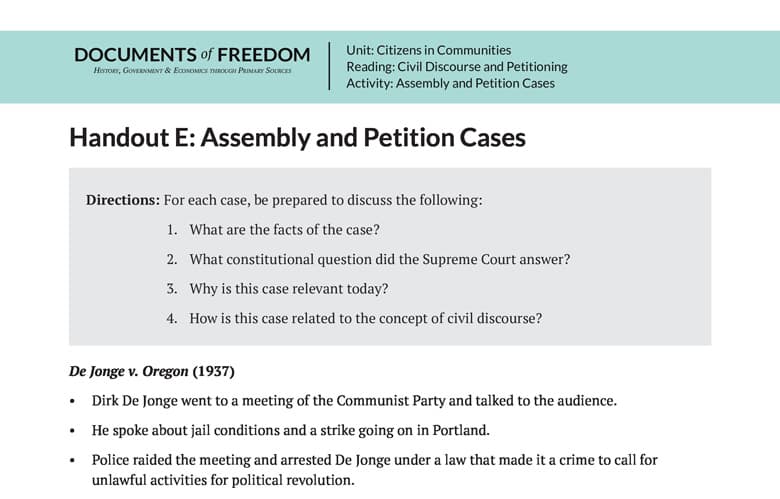Handout E: Assembly and Petition Cases
Handout E: Assembly and Petition Cases
Directions: For each case, be prepared to discuss the following:
- What are the facts of the case?
- What constitutional question did the Supreme Court answer?
- Why is this case relevant today?
- How is this case related to the concept of civil discourse?
De Jonge v. Oregon (1937)
- Dirk De Jonge went to a meeting of the Communist Party and talked to the audience.
- He spoke about jail conditions and a strike going on in Portland.
- Police raided the meeting and arrested De Jonge under a law that made it a crime to call for unlawful activities for political revolution.
- De Jonge claimed he had not called for unlawful action. He had just gone to a meeting of a group that favors political revolution and discussed current events.
- In a unanimous opinion written by Chief Justice Hughes, the Supreme Court noted that De Jonge did not actually call for immediate violent actions. The Court therefore held that the First Amendment protected De Jonge’s freedom of speech and assembly. Attending a meeting of the Communist Party could not, by itself, be reason for arresting someone.
Cox v. Louisiana (1965)
- Elton Cox led 2,000 students in an anti-discrimination march to the state courthouse.
- Protestors followed police directions and did not disturb traffic.
- Cox told protestors that they should demand service at nearby segregated restaurants.
- When they heard the protestors’ plans, police pushed them away with tear gas.
- Cox was arrested the next day for disturbing the peace.
- In a unanimous opinion written by Justice Goldberg, the Supreme Court ruled his arrest was unconstitutional because the demonstration did not result in a breach of the peace. Calling for actions that might result in violence (blacks asking to be served at whites-only lunch counters) was also not a breach of the peace. Freedom of assembly cannot be denied because the government disagrees with someone’s message.
Gregory v. City of Chicago (1969)
- Civil rights demonstrators marched to the mayor’s house in Chicago to ask for desegregation in
public schools. - Mr. Gregory addressed the marchers and said: “First we will go over to the snake pit [city hall]. When we leave there, we will go out to the snake’s house [the mayor’s home]. Then, we will continue to go out to Mayor Daley’s home until he [desegregates the schools].”
- The marchers sang into the evening but stopped at 8:30 P.M.
- The demonstrators were peaceful, but police worried about the chance of violence as more and more people came to see what was going on.
- At 9:30 P.M., police told the demonstrators to leave or they would be arrested. They did not leave, and were arrested for disorderly conduct.
- In a unanimous opinion written by Chief Justice Warren, the Supreme Court ruled that the demonstration was “peaceful and orderly,” and therefore it was “well within the sphere of conduct protected by the First Amendment.”
Edwards v. South Carolina (1963)
- Almost 200 civil rights protestors organized a march to the South Carolina State House.
- The marchers broke into groups of 15 and walked and sang in protest of segregation policies.
- The marchers were peaceful, remained on public property, and did not disrupt traffic.
- Thirty police officers ordered the group to leave. The marchers did not obey the order.
- The protestors were arrested and charged with breech of the peace.
- In a 8-1 decision written by Justice Stewart, the Supreme Court ruled that South Carolina had violated the marchers’ rights to free speech and assembly. The Court explained that the marchers were exercising their First Amendment rights “in their most pristine and classic form.” Further, the Court held that the First Amendment ensures that a state cannot arrest people for “the peaceful expression of unpopular views” as South Carolina had done.
Lloyd v. Tanner (1972)
- Five students passed out leaflets in protest of the Vietnam War inside a privately-owned shopping mall.
- The five young people were quiet, orderly, and did not litter. One shopper complained.
- Security guards told the students they were trespassing and they would be arrested if they did not stop handing out the leaflets. The guards suggested they move outside to the public sidewalk.
- The students argued that even though the mall was privately owned, that it served the purpose of a public business district and therefore they should be able to hand out their leaflets peacefully.
- In a 5-4 decision written by Justice Powell, the Supreme Court ruled that people do not have a First Amendment right to assemble on private property. The Court noted that just because the mall is open to the public, “there is no open-ended invitation to the public to use the center for any and all purposes.” The Court went on to explain that the First Amendment “safeguards the rights of free speech and assembly by limitations on state action, not on action by the owner of private property…”
